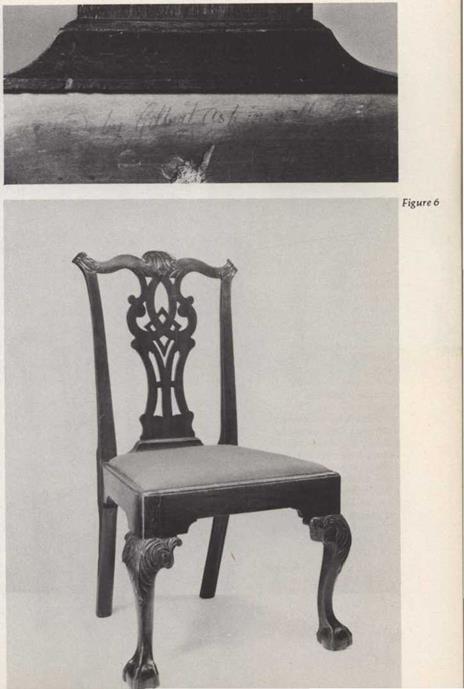Handsome but rigidly controlled and shallow carving is a distinctive New York feature (Fig. 5a). The rear feet of Figure 5 (Fig. 5c) and the four-square claw-and-ball feet of Figure 6 are also familiar New York features. But the front feet of Figure 5 and the so-called stump rear legs of Figure 6 are more characteristic of Philadelphia chairs.
An unoriginal inscription (Fig. 6a) has been the basis for attributing much New York furniture to Gilbert Ash.’ Fig. 5: mahogany, red cedar, red oak, white pine; 1755-65; H 39’/s" (99.3 cm); one of a pair; acc. no. G57.545.1. Fig. 6: mahogany, American beech; 1755-65; H 38V (98.4 cm); no. Ill of a set; acc. no. G56.98.3.
|
|
|
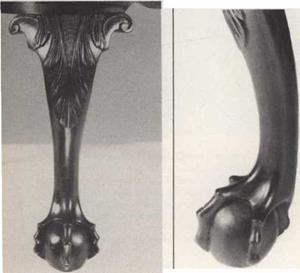
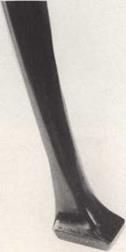
|
|
Figures 7 and 8. Side Chairs. The shaped rear leg ending in a platform, found on so many New York chairs (Figs. 5c, 7), is derived from English sources. Seating a splat directly into a combined rear seat rail and shoe (Fig. 7) is also an English practice. In colonial America, splats were usually seated in a separate shoe attached to the rear seat rail (Fig.
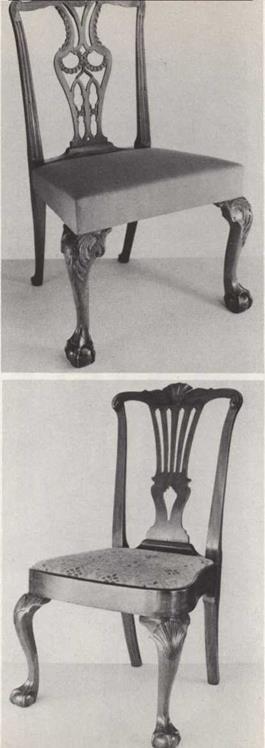 8). Figure 7 includes stop-fluted stiles,
8). Figure 7 includes stop-fluted stiles,
Gothic arches and tracery, and ruffle carving on the splat. The crest rail is related to Figure 8, but in recognition of the "modern" taste it turns up to form slight ears.
With a balloon seat, shell carving on the crest rail and knees, and a crest rail flowing into its stiles Figure 8 is an illustration of Queen Anne design retained well into the Chippendale period. According to family tradition, it is one of a set of 12 chairs made about 1779 when General Samuel Blachley Webb married Elizabeth Bancker. Fig. 7: mahogany, soft maple, birch; 1760-80; H 377/s"
(96.2 cm); acc. no.
G52.243. Fig. 8: mahogany, red gum, oak, tulip;
1770-80; H 39’W (99.6 cm); no. II of a set; acc. no. G59.2835.
Figure 8
Figures 9 and 10. Side Chairs. A serpentine crest rail, pronounced ears with leaf carving, foliage carving—once described as "dripping stalactites on the splat, pierced and unpierced fretwork on the stretchers, and straight front legs indicate that the maker and owner of Figure 9 were conversant with the Chippendale style. Robert Manwaring’s The Cabinet and Chair Maker’s Real Friend and Companion (London, 1765) contains a design from which the splat of Figure 10 was adapted. Punchwork accents a portion of the splats of both chairs. Square claw-and-ball feet and a feeling of solid expanse, heightened by carved gadrooning on the front seat rail, are aspects of New York origin. Fig. 9: mahogany, white oak; 1760-80; H 39V<" (99.6 cm); acc. no. 57.51. Fig. 10: mahogany; 1765-75; H 385M" (98.1 cm); no. VII of a set, one of a pair; acc. no. C52.244.1.
Figures 11 and 12. Side Chairs. Figure 11 is proof that sophisticated chairs were produced in New York City. Plate XIII (1754 ed.)and Plate X(1762 ed.) of Chippendale’s Director furnished the design source for its back. Typically, elements such as the pierced crest rail and Gothic arches in the splat were selected and rearranged. Chippendale’s advice for chairs of this type was followed by many American craftsmen: "If you think they are too much ornamented, that can be omitted at pleasure." Somewhat freer rococo carving on the knee brackets of Figure 12 and the simple device of dividing the crest rail as it joins the splat to produce a ribband effect, make this tassel-back chair appear superior to chairs that are related to Figures 1 and 2. These chairs were owned originally by the Wright family of Oyster Bay,
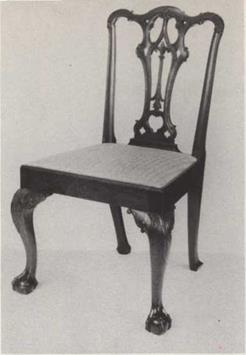
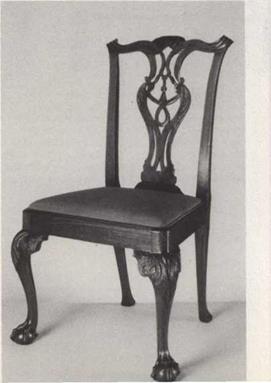 N. Y. (Fig. 11) and by Elias Boudinot, lawyer, patriot, and statesman whose family was rooted in New York and New Jersey (Fig. 12). Fig. 11: mahogany; 1765-80; H 38’k" (97.8 cm); no. VIII in a set, one of four; acc. no.
N. Y. (Fig. 11) and by Elias Boudinot, lawyer, patriot, and statesman whose family was rooted in New York and New Jersey (Fig. 12). Fig. 11: mahogany; 1765-80; H 38’k" (97.8 cm); no. VIII in a set, one of four; acc. no.
G58.1784.4. Fig. 12: mahogany, red pine; 176580. H 38 Уг" (97.8 cm); acc. no. G51.66.2.
Figure 12
Figures 13 and 14. Back and Foot Stools. Side chairs with upholstered seats and backs (Fig. 13) were called French, stool back, back stool, and stuffed chairs in the Chippendale period. Newspapers record their use in New York by 1765 and Rita Susswein Cottesman’s The Arts and Crafts in New York,
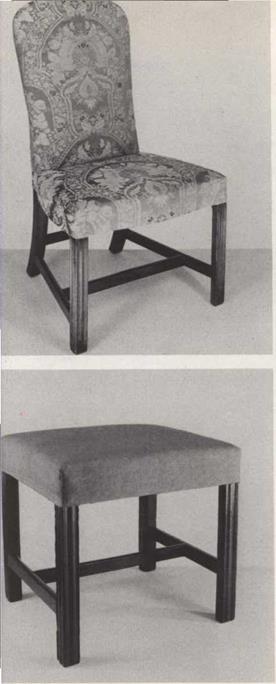 1726-1776 records that Theodosius Fowler, upholsterer, advertised in 1774 that he made "backstool chairs finished in the genteelest and newest taste." Upholstery was expensive in the 18th century and, therefore, many colonial chairs only have upholstered slip seats. It is only a "best guess" that these stools were made in New York. Both have cherry seat frames, a wood used by cabinetmakers there but also employed elsewhere for construction.
1726-1776 records that Theodosius Fowler, upholsterer, advertised in 1774 that he made "backstool chairs finished in the genteelest and newest taste." Upholstery was expensive in the 18th century and, therefore, many colonial chairs only have upholstered slip seats. It is only a "best guess" that these stools were made in New York. Both have cherry seat frames, a wood used by cabinetmakers there but also employed elsewhere for construction.
The similarity of the "Chinese Chippendale" molded straight legs and plain stretchers of both stools is obvious. The legs of a New York slab, or pier, table may also be related to these stools (Fig. 33). Other upholstered New York furniture is illustrated in Plates l through III. Fig.
13: mahogany, cherry;
1765-80; H 37’h" (94.5 cm); acc. no. G59.1876. Fig. 14: mahogany, cherry, white pine;
1765-85; H 18’/г" (47 cm); acc. no. C59.2845.
Figure 14

